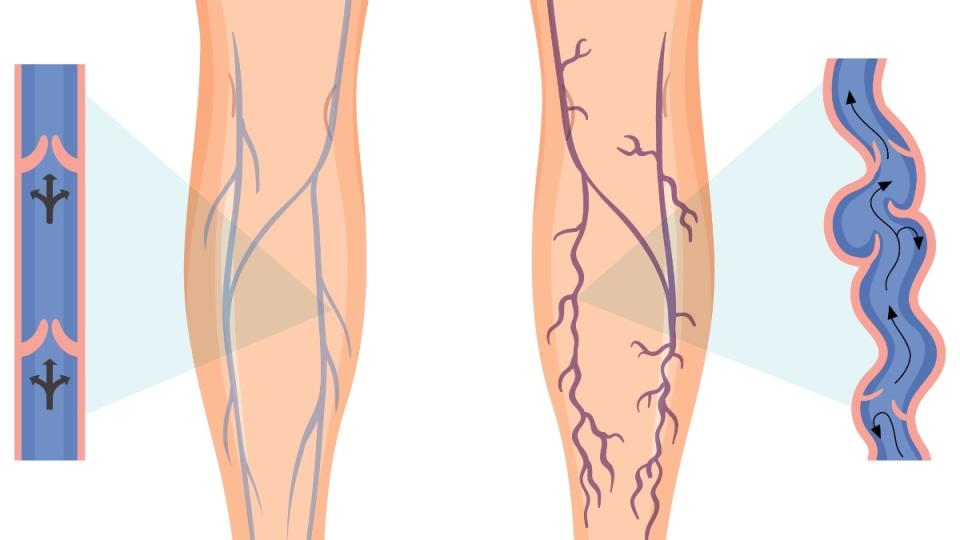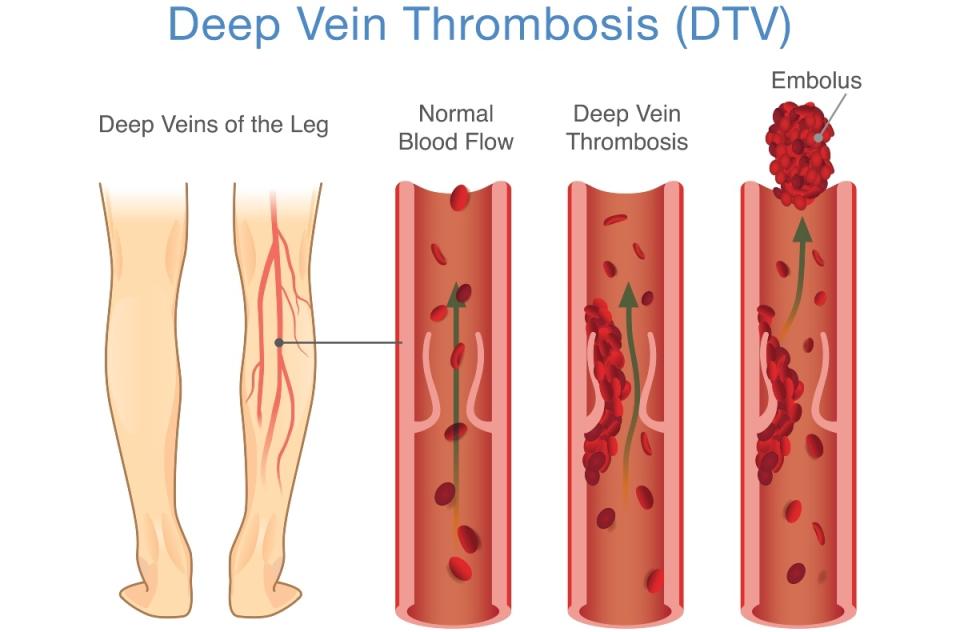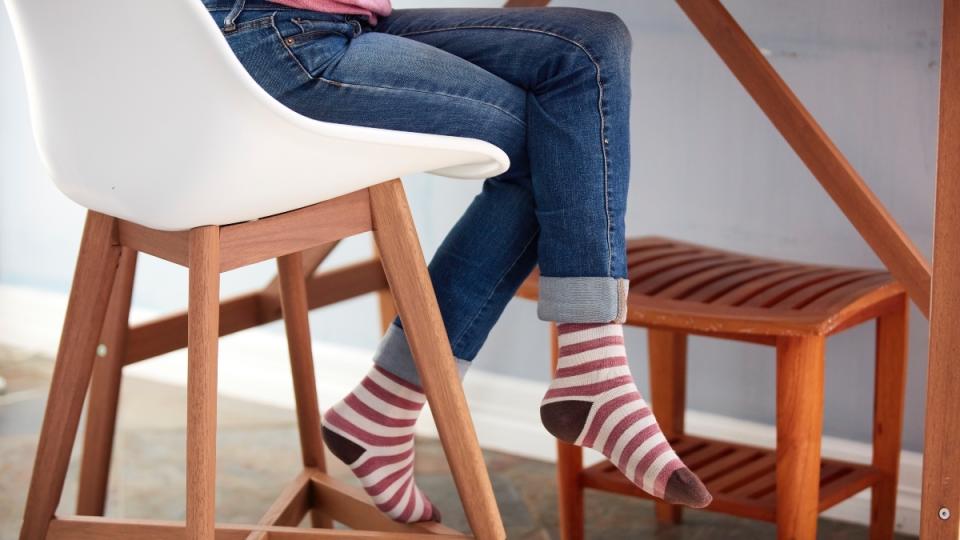Compression Socks Can Dramatically Improve Your Sleep — But Only If You Wear Them During The Day, Say Vascular Experts
If you've ever slipped on a snug pair of socks when your legs are achy, you're familiar with how compression socks (also known as compression stockings) can soothe discomfort. Not only can they tamp down painful swelling and rejuvenate tired legs, but they also help with conditions like varicose veins. So it stands to reason that if they're so beneficial when worn during the day, they'd provide similar perks at night, right? Not exactly. While it's true that you can sleep in compression socks, they'll do a whole lot more good when you wear them during the day instead. Read on to learn how — and when — to wear them to maximize the benefits.
Understanding what compression socks do
Compression socks are designed to gently squeeze the legs to promote better blood flow. They're more snug than standard socks, and they can vary in length and support level. They're often recommend for people who stand or sit for long stretches at a time, and also during travel. Why? When you’re in those positions, it can be hard for your veins to pump blood up from your legs back to your heart. As a result, the blood ends up settling in your legs and ankles, causing those areas to swell and ache.
The problem tends to worsen with age, when vein walls become weaker and make it harder pump blood upward. Not only can this be painful and tiring after a long day on your feet, but over time, it can lead to issues like varicose veins. This occurs when vein walls become weak and allow blood to pool or flow backward, causing an enlarged, protruding appearance (they’re often described as "twisted"). The result: painful symptoms like throbbing, itching, a feeling of heaviness, and leg cramps. (Click through to learn how compression socks and witch hazel can help heal varicose veins.)

The benefits of wearing compression socks
This where compression socks come in. “The compression stockings help squeeze the veins in order for them to continue blood flow upwards,” explains Joseph Daibes, DO, an interventional cardiologist and founder of New Jersey Heart & Vein in Clifton, NJ. They can be used as a preventative measure to help stop swelling before it even starts. And they can also help relieve symptoms after they've already flared up, such as pain from varicose veins or swollen ankles.
1. They prevent restless legs syndrome
Restless leg syndrome (RLS) is characterized by a twitchy, unbearable urge to move your legs. It most often flares up in the evening and overnight. Luckily, donning compression socks during the day can help. Gentle pressure on the leg muscles send RLS-easing signals to the brain when you lie down at night. Researching reporting in The Journal of the American Osteopathic Association found that the strategy was 140% more effective than drug treatments, and helped folks sleep 82% more soundly within eight weeks. (Click through to our sister publication to learn how magnesium can ease restless leg syndrome.)
2. They ward off nighttime bathroom breaks
Another nighttime condition the can compression socks can help: nocturia, or the urge to urinate overnight. The socks work by preventing fluids from pooling in your legs and flooding your kidneys when you lie down at night. They're so effective, a study in the journal Cureus found they can help you skip a nighttime bathroom visit and sleep undisturbed more than 45 minutes longer than if you hadn't worn the socks. (Click through to our sister publication for more ways to outsmart female bladder problems.)
3. They block snoring
Much in the same way compression socks reduce nocturia, they can alleviate sleep-sapping snoring, too. A study in Respiratory Physiology & Neurobiology found that wearing compression socks during the day reduces snoring by 36% by preventing excess fluids from pooling at (and swelling) throat tissues while you snooze.
4. They reduce the risk of clots
Compression socks are a smart bet when traveling, too. Long stretches spent sitting while on a plane, train, bus or in a car can raise the risk of deep vein thrombosis (DVT), a blood clot that usually forms in a vein in the legs. The clot (or embolus) can be especially dangerous if it breaks free and travels to the lungs. But research published in The Lancet found compression socks clots from forming by giving legs a gentle squeeze, slashing DVT odds in high-risk folks up to 63%.

Why compression socks aren't helpful when you sleep
As beneficial as compression socks are during the day, it turns out you’re not reaping those same rewards when you sleep. What's odd is that wearing compression socks during the day can help alleviate symptoms the interrupt sleep...but you don't want to wear them when you sleep. That’s because when you snooze, you’re lying flat. This means your blood is able to circulate much more easily, and you don’t need that added assistance from the compression socks. “Compression socks aren't offering any benefit if you’re able to lie down because gravity is doing the work that the compression socks are trying to overcome,” explains Kristin Cook, MD, a vascular surgeon at Hackensack University Medical Center in Hackensack, NJ.
While there are some circumstances in which a physician might advise wearing them overnight — for instance, if you’re not able to lie flat or you have severe swelling and it provides more comfort — overall, it’s unhelpful for the average person.
Surprisingly, that's even true for conditions that flare up at night, such as RLS, nocturia and snoring. It might seem counterintuitive, but wearing compression socks during waking hours is what’s recommended to ward off these nighttime conditions. That's because improving circulation when you're active on your feet prevents blood pooling and swelling that can flood your body and irritate nerves and tissues overnight. Preventing the swelling from occurring in the first place decreases nighttime symptoms, explains Eileen de Grandis, MD, vascular surgeon and medical director of the Vein Clinic at Lynn Heart & Vascular Institute at Boca Raton Regional Hospital, FL.
*Never* sleep in compression socks if you have PVD
While wearing compression socks when you sleep isn't as helpful, it's not harmful for most folks. So if you come home from a long day at work and wind up falling asleep in your compression socks, don't sweat it. “Most of the time, it’s not dangerous for most healthy people with a healthy arterial system,” says Dr. Cook.
You may notice some skin irritation with longterm, round-the-clock wear — the socks are tight, after all — but most importantly, they’re just not doing their job when you’re lying down. As Dr. Daibes notes, “It’s not harmful, but it may not be helpful."
An exception: People with venous conditions such as peripheral vascular disease (PVD), a circulation disorder which can cause narrowing or blockage of blood vessels, should avoid wearing compression socks when they sleep. Too much compression can limit blood flow to the feet and worsen symptoms like cramping, explains Dr. Daibes.
The best time to wear compression socks
To get the most out of your compression socks, experts advise wearing them for about 8 to 12 hours when you’re awake. “I tell people it’s a 9-to-5 job,” says Dr. de Grandis. She recommends putting them on in the morning after you wake up and then taking them off around dinnertime. Essentially, keep them on for the time-frame you’ll be on your feet or sitting during the day.
Having worn compression socks for the past 15 years, it’s advice Dr. de Grandis takes herself. “I really wear mine only during working hours,” she says. And if you wear them regularly during the week like Dr. de Grandis, you'll find that you might not even need them come Saturday and Sunday. “My working hours are anywhere between 10 to 12 hours a day. But I don’t wear them on the weekends. If I wear them that much during the week, my legs feel great on the weekends,” she says.
And if you can’t make it through the whole day right off the bat, that's okay. “Everyone gets into their own rhythm of how much they want to wear them," Dr. de Grandis explains. "I would say generally, though, if you wear them less than four hours a day, it’s not super helpful. But, you can build up to it.” Start with what you’re comfortable with, aiming to wear them through most of the day as time goes on, she suggests.

How to maximize the benefits of your compression socks
Ready to reap the rewards of wearing compression socks? These simple tips can help you get the best health-boosting bang for you buck.
1. Choose the right size
There’s no standard sizing when it comes to compression socks. But it’s important that they fit well. “You don’t want your compression stockings to be too tight where they’re suffocating your legs, but you also don’t want them to be too loose where they’re not doing anything,” explains Dr. Daibes.
Your best bet? Break out a soft tape measure, say Dr. de Grandis. Fit can be based on the size of your ankle, calf width, and/or shoe size, depending on the brand. If there’s a size discrepancy — say, your ankle puts you at a size small and your calf width puts you at a medium — go with the largest measurement. “If you are between two sizes, always round up,” Dr. Cook advises. You can also get professionally measured at a specialty store like a pharmacy or by your doctor if you're struggling to pinpoint the right size. To dodge common mistakes when wearing your socks, check out the video below.
2. Opt for the ideal compression grade
Once you've nailed down the right size, you'll want to take note of the compression grade, too. This measures how snug the socks fit, and it's often broken down in levels to indicate how much pressure is provided. Lower levels, like 10 to 15 mmHG, are ideal for when you’re using your socks as a preventative measure, says Dr. Cook. Higher compression grades, like 30 mmHG and up, are considered medical-grade compression socks and reserved for those with health issues as discussed with your doctor.
3. Skip the washing machine
To extend the life of your socks, wash them by hand, recommends Dr. Cook. Why? “The pressure is based on the elasticity of the sock," she says. "If you are washing them and drying them in a machine, they will lose that elasticity faster and may not be providing the same grade compression that is stated on the box.”
4. Replace them regularly
Similarly, experts recommend getting a new pair at around the 3 to 6 month mark. This is another reason to skip sleeping in them. As Dr. de Grandis explains, the six-month swap is based on regular daily — not around the clock — use, since the stretch wears out. So if you don them more often, “you’re going to replace these expensive stockings more frequently,” she says. (Many fall in the $15-$30 range per pair, though some can retail much higher.) Once you've found the perfect pair, you can dodge common mistakes when wearing your socks by checking out the video below.
Find the best compression sock style for you
Whatever your needs (or style!) compression socks are more popular than ever. That means there's a wide variety to choose from when it comes to nailing down the perfect pair. Here, we've rounded up 3 smart picks.
1. Best fashion-forward socks
For folks interested in fun, stylish prints, try this microfiber version from Sigvaris. It comes in everything from pink stripes to blue argyle. As one reviewer put it, “With these I feel fun and active, and I don't believe I have one foot in the nursing home and the other on a banana peel. They make me WANT to get up and get moving.” (Buy from Amazon.com, starting at $37.96)
2. Best budget-friendly socks
With over 49,000 (!) ratings, it’s no wonder these Hi Clasmix compression socks are a popular pick. They come in a huge range of colors and cute patterns, and offer higher grade compression for added relief. The best part? They start at as little as $ 13.59 for five pairs! (Buy from Amazon.com, starting at $13.59.)
3. Best shorter socks
If you're mostly bothered by swollen ankles and puffy feet, you may not need longer-style compression socks that go as high as your knees. A better bet: CEP's crew cut compression socks. They have ventilation to keep you cool (goodbye, sweaty feet!) and can be worn when you're exercising or being active, too. (Buy from Amazon.com, starting at $15.95.)
Read on for more natural ways to alleviate leg and foot pain
Nutritionist: Pickle Juice *Does* End Leg Cramps — But Not for the Reason You Think
Rheumatologist: Never Ignore Big Toe Pain — It Can Be the First Sign Of Underlying Disease
This content is not a substitute for professional medical advice or diagnosis. Always consult your physician before pursuing any treatment plan.
